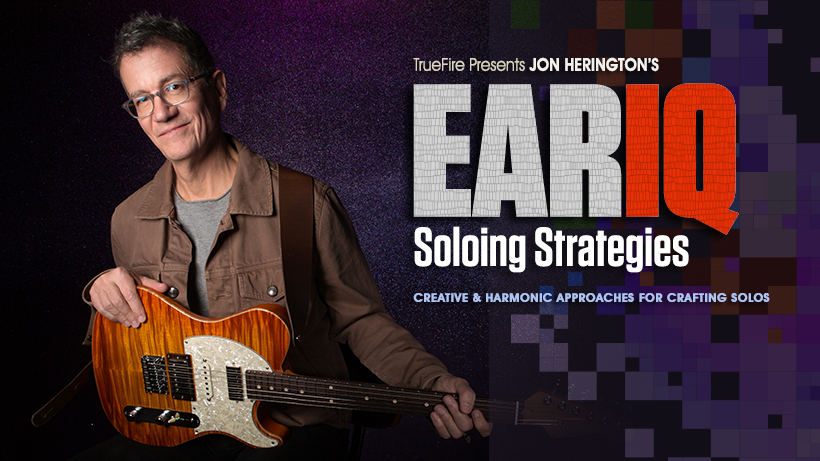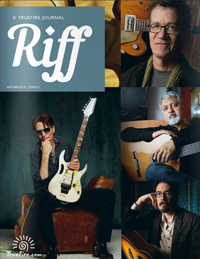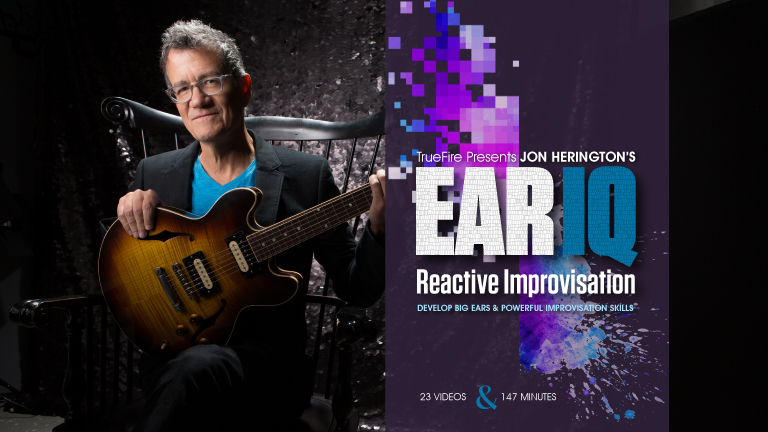NEW! EAR IQ Soloing Strategies
INSTANT DOWNLOAD price $39
DISC & DOWNLOAD price $59

Cart link will take you directly to TrueFire.
Have you ever played a solo and been less than happy with the result? Maybe your solo doesn’t feel like it fits the song, maybe it’s too predictable, maybe you’re not engaging the audience. Easy fix!
Jon Herington’s Soloing Strategies edition of Ear IQ will impart ten true proven approaches for crafting engaging, memorable solos for any style, any tune.
”Over the years, I’ve discovered there’s A LOT you can do to dramatically improve the way you build a guitar solo. In this course, I’ll open your ears wide to 10 soloing strategies that I’ve personally found to be most effective. We'll take an in-depth look at 10 of my solos, and focus on the particular strategy for each one. I’ll also provide tips for working all of the strategies into your solos and improvisations.”
"Jon Herington is a real TrueFire virtuoso. He is an equally fantastic instructor. I'm hanging onto every word and demonstration in this video series. Cheers!" - Don Compton, TrueFire Student
For each of the ten soloing strategies, I will first explain the strategy and analyze a track that we will apply the soloing strategy over. I will then solo over the track and provide a detailed breakdown of solo emphasizing the how the strategy was applied.
Strategy 1: Consider Character - ”Whenever I sit down to record a solo on a tune, the first thing I do is listen with the idea of zeroing in on the overall character of the song. I do a sort of a general assessment of the style (is it some kind of rock, blues, jazz, country, folk, roller disco, or some mix of them, etc.), and try to get an idea of the attitude of the song by listening to the lyrics if there are any (is it earnest, funny, ironic, angry, etc.). Once I have a sense of the world I'm going to add something to, I start to imagine an approach to the sound I want to make. The idea of getting the right character is critical to me - I like to look for the answer to the question: what is the music asking me to play? The first track we're going to look at is a Donald Fagen tune loaded with the character called H Gang.”
Strategy 2: Work the Style - ”Sometimes the single most important thing to address when coming up with a solo is the style. Often a job is even presented as centered around a style. I'll get asked, "Can you play a Rockabilly solo?", Or someone will say, "Play this like Wes Montgomery," or, "I need a Stevie Ray sound," etc. This is similar to the character, of course, but it's a factor that I've had to deal with, and I still do that even when I'm making my records since style is such a powerful thing. The second solo we're going to look at is from one of my recordings, and it's called Thirteen Feet of Rain.”
Strategy 3: Think About Shape - ”The shape of a solo, as I mean it, is a sort of imaginary graph of the melody. Where does it start, high, low, or in the middle? How does it move, does it go up, down, are there little shapes that repeat? And what is the overall or general shape or arc of the solo? Can it be simplified if you ignore some of the details, and if so, what can we learn from that? And what are the emotional effects of differently shaped solos? This next solo is over the track for a song called She Reminded Me of You"
Strategy 4: End Well - ”If you're paying attention, you don't have to be doing live performances for very long before you realize how important it is to make sure things end well. Any ending is what you leave in the audience's collective ear, whether it's the end of your set, the end of a song, or the end of your solo; it's when they get the silence and the space to really consider what they've been listening to and what they think about it. So, it's critical to take care of business where endings are concerned. This is true, naturally, even when playing a guitar solo in the song.”
Strategy 5: Engage Your Audience - ”A time-honored way of creating interesting melody - which is what playing a guitar solo is all about - is to use the technique of theme and variation. Classical composers have used this technique for hundreds of years, and it's the basis for most jazz improvisation. There's something about the way it plays with the listener's expectations, sometimes satisfying them, sometimes surprising them, but in the best cases, always keeping them engaged. Here's a solo for a song composed by my good friend and Steely Dan bandmate Jim Beard.”
Strategy 6: Create Collections - ”Those of you who know my first TrueFire course know that I talked quite a bit about what I called "collections" of notes. Collections are groups of notes that are put together to use as raw materials for improvising on a song because of their power in zeroing in on the sweetest or juiciest sounding notes to play over a sounding chord or for any particular desired effect. In this next solo, we're going to look at, on a tune of mine called I Hear They Shoot Horses.”
Strategy 7: Consider Tradition - ”When I had the good fortune to be asked to play guitar for Steely Dan many years ago, I jumped at the chance, naturally. I had an unbelievable amount of material to learn in a very short time. I wanted my playing to serve the music as a whole, and be true to the character and quality of the records, but I didn't want to be a mimic - I wanted to serve the music and not disappoint people who loved the records, but I also wanted the freedom to improvise, and to make the music my own, to put my spin on it. It was clear to me that I had work to do. It wasn't always easy to find the balance between honoring the original solos and finding room of my own. This next solo is an example of the results of one of my attempts.”
Strategy 8: Sing Your Lines - ”Another strategy I recommend is to try singing your solo before playing it. Sometimes the best way to get your ear working is to stop your hands from playing first. All too often players get in the habit of playing what I call "hands first," instead of "head first," or maybe better yet, "heart first." After all that expression "play by heart" is all about playing music that's become a part of you, that's internalized. There are a lot of circumstances where an attempt to sing some pure, appropriate musical idea can lead you to new things that you wouldn't typically play on the guitar, and that's a great thing!”
Strategy 9: Compose Yourself - ”If I had to reduce all my teaching over the years to the best single nugget of advice I've had to give, it would be this: If you want to learn to improvise better on a song, compose what you wish you could improvise; do it again, and again, and again… When you can stop time, fix what you don't like, hone and polish it until you love it, you're teaching yourself a lot about what works in that musical context, and if you make a regular practice of that kind of thing, you'll find your ability to improvise and spontaneously create new stuff in real time will improve dramatically. So, I recommend it.”
Strategy 10: Employ “Flash" - ”I love to improvise. It can be one of the most exhilarating feelings in the world, but it can also be one of the most terrifying. On this last track, another Steely Dan classic, "Bodhisattva," when I first learned it years ago, I struggled with the chord changes and how to approach playing on it and over the years I began to feel pretty comfortable improvising on it. Then one year at the beginning of a new tour, we played it, and I found myself struggling all over again - it was like some weird recurring nightmare. I didn't know what was going on. One night backstage, Keith Carlock, our world-class drummer, said something like, "Oh, I changed the tempo of that tune this year - it's a lot faster than we used to play it." And you can imagine both my relief and my continued frustration. Anyway, since it was more challenging at that faster tempo, I needed a new strategy desperately, and I decided to script that solo, for the most part, anyway. Since it's a sort of big, fast, crowd-pleaser of a song, I tried to come up with some flash - some show-biz.”
"I am so excited to see this coming to TrueFire! Like many others, I loved his Ear IQ course and think this is going to be as good or better :-D" - Kenneth GonzalezI will explain and demonstrate all of the key concepts and approaches along the way. You’ll get standard notation, tabs, and diagrams for the key examples and performance studies. Plusthe course includes all of the rhythm tracks for you to work with on your own. Also, you’ll be able to loop or slow down any of the performances so that you can work with the materials at your own pace.
Grab your guitar, put your ears on, and let’s get strategic!
What You Get:


